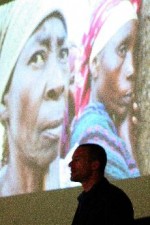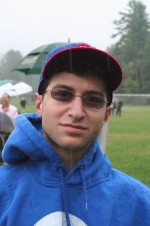Journalist searches for truth

“A World Of Conflict” was written in blood-red letters on the giant projection screen behind Yahoo.com’s Kevin Sites as he began his presentation on March 5. “Do you believe there will be peace, or do you believe you will go back to fighting very soon?” Sites said, his voice drifting through the speakers as images of disaster, fighting and death flashed before the audience’s eyes.
Sites, a multimedia journalist, was the first Yahoo News correspondent who created a Web site titled “Kevin Sites in the Hot Zone.” Before working with Yahoo News, Sites was an embedded correspondent for CNN and NBC. From September of 2005 to September of 2006, Sites traveled as a solo-journalist to 20 different war zones.
The two-hour Soundings event consisted of two different parts; an hour-plus presentation and another hour discussion in which the audience could ask any questions. The white folding chairs that lined the floor of the Glenbrook Gym were more than half filled with students in honor of the Soundings keystone event speaker.
To aid his presentation, Sites used the war zone same laptop he traveled with to project images on the screen. Sites started off with a three-minute video of small clips from his year in the hot zones.
“If you’re risking your life to tell a story, there has to be a payoff. For me I wanted to learn something,” said Sites.
For him, the payoff would be the truth. According to Sites, the media only covers part of what war is about, combat. In 2004, while Sites was an embedded correspondent for NBC in Fallujah, he filmed a U.S. Marine “executing” an insurgent. When the coverage was shown, the shooting itself was removed for U.S. viewers while the rest of the world viewed the raw footage.
Sites gave his approval to cut out the full shooting, but now feels it was a horrible mistake.
“We were nominated for an Emmy for this piece, we shouldn’t have been. We didn’t trust you with the truth,” he said.
As a journalist, Sites knows it is his duty to report and tell the truth. This story “sowed the seeds of confusion,” by not giving the viewers the whole story to make decisions on their own. Sites said he received a lot of angry e-mails in regards to this decision of censorship.
Then, he said, he was “saved by the blog.”
In response to his torn feelings on the Fallujah shooting, Sites wrote a 2,600-word blog on his Web site, kevinsites.net. He explained the facts and gave the objective side to the story, a “re-do” as he called it.
“In a world of conflict, the truth must survive, he told students.
“Kevin Sites In the Hot Zone” was the result. He said he was determined to tell the full story from that day forward. His mission was to cover every armed conflict as a solo-journalist, and to do it all in a year. He felt as if he needed to show all of the people affected by war; soldiers, victims and civilians alike.
He stopped “headline chasing,” and focused on the small, human stories to put a human face on global conflict.
Working alone allowed Sites to get close to the people and places he wanted to visit. He decided to use new technology with traditional narrative to tell these stories. Sites documented his journey by using a video camera, laptop, satellite phone, and still camera. He would gather all of the information, and send it back to his Yahoo team in Santa Monica who would put it up on the Web site.
Sites spoke of his travels to places like Africa, The Democratic Republic of Congo, Lebanon, Israel and Iran. During his visit to Africa, Sites felt as if he missed many opportunities because he did everything wrong. He would write about events like African dances rather than film them, or he would film when nothing was going on. Soon enough, he developed a rhythm using video for movement, text for nuances and still photos to show the human face.
The most moving place Sites visited was The Democratic Republic of Congo. The place has been in constant conflict since 1997, and 5.4 million people have died. Most of these causalities have been due to starvation, land mines and sexual violence, he said.
“The attrition of war kills more than bullets,” he said.
There are more brutal rapes in the Congo than anywhere else in the world, he said, and he shared the moving story of a woman he met named Serapina — a woman whom he said he’ll never forget.
Serapina was raped by six militia men, and then she watched them burn down her house, he said. Her two children were murdered and all the while, her husband was tied to a tree, being forced to watch his family suffer. As if this was not enough tragedy, months later, Serapina was raped by three men, her husband was murdered, and she was forced to eat the flesh from his arms.
Serapina shared her story with Sites because this was the only weapon she had. If she could tell others about her story, maybe something will be done.
“War is not always about the clash of armies, but the destruction of civil life,” said Sites. “In some ways we define war improperly. We define it by its smallest feature. We define war as combat. But in a lot of ways the largest feature of war is the collateral damage.”
To round out his talk, Sites challenged the audience to be responsible for making the media tell the truth. He encourages everyone who does not feel satisfied with the news they are receiving to go out and find out the real news themselves.
“We’re not telling you enough about what is going on,” Sites admits.
During the discussion that followed many members of the audience asked Sites questions, so many that time ran out.
Former Marine and Castleton senior Rick Pena` thanked Sites on behalf of the Marines for telling the story from all sides.
“I’m glad that he stood up and took the courage to go out on his own to get the true story out there,” said Pena`.
Audience members flocked to the podium to speak with Sites, to tell him just a little bit about what they took from his talk.
“His speech was very informative and wasn’t a waste of a Wednesday night. It kind of opened my eyes that the news isn’t exactly what it appears to be. I thought it took a lot for him to admit his faults. It was very noble,” said freshman Greg Lamoy, waiting for an autograph on his copy of Sites book.
“I learned that you have to search out the independent media. I’d rather get the truth then be lied to. I know when I watch the news, I’m not getting the whole story,” said sophomore, Nate Buchman.
“My role as a journalist is simply this. The truth is perhaps the one thing I can bring out of a conflict,” said Sites.





